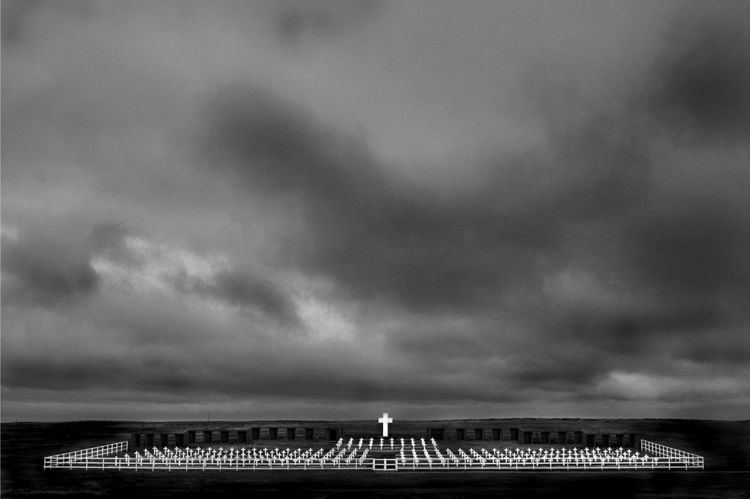Established 1983 (1983) Total burials 237 | Total commemorated 412 Unknown burials 123 | |
 | ||
Address FIQQ 1ZZ, Falkland Islands (Islas Malvinas) Burials Jorge Casco, Pedro Giachino Similar Darwin House, Goose Green, Mount Pleasant Airport | ||
Argentine military cemetery falklands
The Argentine Military Cemetery, Spanish: Cementerio de Darwin (Darwin Cemetery), is a military cemetery on East Falkland that holds the remains of 237 Argentine combatants killed during the 1982 Falklands War (Spanish: Guerra de las Malvinas). It is located west of the Darwin Settlement close to the location of the Battle of Goose Green.
Contents
- Argentine military cemetery falklands
- History
- Attempt at Identification using DNA
- 2012 vandalism
- 2017 vandalism
- State of interments
- ARA General Belgrano
- Buried other places
- Remains not recovered
- References
History
In December 1982 the British government commissioned a firm of civilian undertakers to consolidate all of the temporary Argentine graves on the Islands to a single location. Assisted by the armed forces, they identified each Argentine grave site and brought the bodies to Port Darwin. At the time this was the largest single Argentine grave site, with the bodies of the 47 Argentine soldiers, killed at the Battle of Goose Green and buried there soon after the battle.
Many of the bodies collected were without dog-tags, so best efforts were made to identify each soldier from personal effects found on the body. Single items were not considered conclusive, but collections were. All were given a Christian burial with full military honours. Each grave is marked by a white wooden cross with the name of the soldier on it if known, but 123 of the crosses simply state Soldado Argentino Solo Conocido Por Dios ("Argentine Soldier Known Only By God").
There is also a common grave containing the 5 crewman of a T-24 Learjet, belonging to Fenix Squadron shot down by a surface-air missile from HMS Exeter, over Borbon Island on June 7. This grave contains the remains of airman: Comodoro Rodolfo de la Colina, Vicecomodoro Juan Jose Ramon Falconier, Major Marcelo Lotufo, Subof Pr Francisco Tomas Luna and Subof Ay Guido Antonio Marizza.
After the conflict the United Kingdom offered to send the bodies back to Argentina, but the Argentine government refused on the grounds that it viewed the islands as part of Argentina.
Until 2004 the cemetery was surrounded by a small white picket fence. The plot is now protected by a walled enclosure with a cenotaph including an image of Argentina's patron saint, the Virgen del Lujan. Surrounding the graves, the names of the 649 Argentine soldiers, sailors and airmen who lost their lives in the conflict, are inscribed on glass plaques, with no indication of military rank or service, as requested by their families.
Since the end of the conflict the bodies of three more Argentine pilots have been interred:
On 9 November 2002 Prince Andrew, himself a Falklands War Veteran, visited the Argentine cemetery and laid a wreath. During the visit the Prince said, "I lost friends and colleagues and I know what it must be like for the great many Argentines who have shared the same experience."
Since the UK-Argentine joint statement on 14 July 1999 Argentine families are responsible for the cemetery's upkeep and in 2007, Sebastián Socodo, an Argentine married to a Falkland Islander, was employed to do the job of cemetery maintenance.
There is a replica of the cemetery at Berazategui.
Attempt at Identification using DNA
Under the terms of a 2016 agreement between Argentina and the United Kingdom, DNA samples will be taken from the remains of the 123 unidentified deceased servicemen in an effort to identify them. The DNA will be compared with that of surviving family members of those who died in the conflict.
2012 vandalism
In July 2012 the glass casing protecting a figure of Argentina's patron saint, the Virgin of Luján, at the head of the cemetery was smashed with what appeared to be an axe. Argentina presented a formal protest to the British government and informed the United Nations and the International Red Cross. Sebastián Socodo, an Argentinian-Falklander responsible for the cemetery's upkeep, said families were notified and that it was not clear when it occurred or who the perpetrators were. Police in the Falklands held an investigation and the glass casing was repaired.
2017 vandalism
A further act of vandalism was found in January 2017, when the glass was broken and the head of the Virgin of Luján statue damaged. The Argentinian Foreign Ministry made a formal complaint to the British Government condemning the vandalism and calling for an enquiry. A Falkland Islands Government statement described the act as "distressing for the families (of the soldiers) and regretted by the people of the Falkland Islands" and an enquiry was begun by the Royal Falkland Islands Police. Former British Foreign Minister Sir Alan Duncan offered his apologies to the Argentine Government, welcoming the enquiry.
State of interments
In total 649 Argentines were killed during the 74 days of the conflict. The Argentine Military Cemetery holds 237 graves.
ARA General Belgrano
The greatest loss of life in the war was in the sinking of the Argentine Navy cruiser ARA General Belgrano, with 321 members of crew and 2 civilians on board at the time, with most of these going down with her.
Buried other places
Remains not recovered
Sixty-one Argentine combatants were lost with aircraft or ships and their remains were not recovered:
